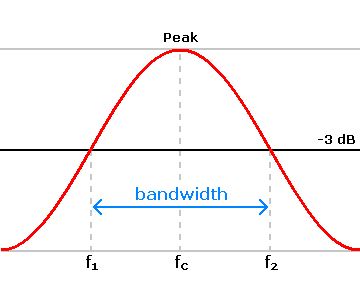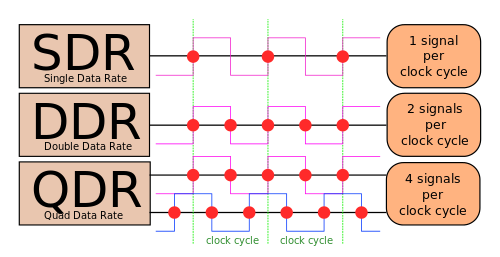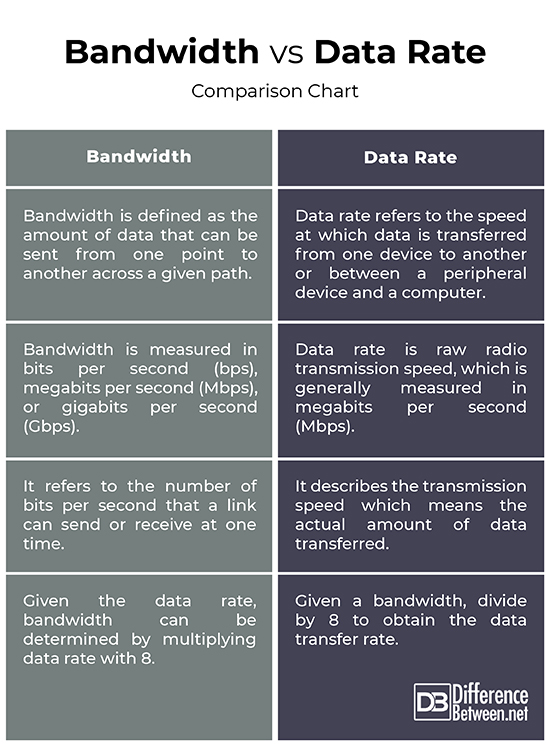Difference Between Bandwidth and Data Rate
In telecommunications, the terms bandwidth and data rate are often used interchangeably, which can be confusing at times. The term bandwidth is often used as a synonym for data rate. Every network connection has a data rate, which describes the rate at which bits are transferred across a network, and bandwidth, which refers to the number of bits per second that a link can send or receive. Let’s take a look at the differences between the two.

What is a Bandwidth?
The demand for higher bandwidth is growing steadily, mostly because of the rising popularity of streaming media, which is now responsible for almost half of all Internet traffic. So, what exactly is bandwidth and how it affects the Internet traffic? Bandwidth is the maximum rate of data transfer of a network or Internet connection for a given period of time. Bandwidth is the amount of data that can be sent from one point to another across a given path. In simple terms, bandwidth allows you to determine how long it will take to download some content over a particular connection. It refers to the number of bits per second that a link can send or receive. For example, the bandwidth of a 50 mbps connection is 50 mbps, but that does not mean it will always send or receive 50 mbps; it is the maximum that can be possible on that link. Bandwidth does not mean data usage. It is measured in bits per second (bps), megabits per second (Mbps), or gigabits per second (Gbps).

What is a Data Rate?
Data rate is closer to bandwidth which is commonly referred to as the transmission speed, or the number of bits per second transferred across a network. There is a rapidly growing need for increased data rates and enhanced quality of service in performance of the wireless communication systems. Continuous efforts have been made by the communication engineers to achieve higher data rates. It is the maximum ability of the channel to transmit bits in a second. So, let’s say if you have a 5MHz bandwidth, then the data rate is 5 mbps, but not necessarily. Data rate refers to the speed at which data is transferred from one device to another or between a peripheral device and the computer. Given a bandwidth, divide by 8 to obtain the data rate. Data rate is raw radio transmission speed, which is generally measured in megabits per second (Mbps) or megabytes per second (MBps). Another relative term for data rate is throughput, which is the actual capacity of a system to send data to another.
Difference between Bandwidth and Data Rate
Meaning
– Bandwidth refers to the width of the band meaning a range within a band of frequencies. Bandwidth is defined as the amount of data that can be sent from one point to another across a given path. It refers to the transmission capacity of a network or Internet connection which determines the speed and quality of the network. Data rate, on the other hand, refers to the transmission speed and is defined as the speed at which data is transferred from one device to another or between a peripheral device and a computer.
Calculation
– Although, bandwidth and data rate are often referred to as the same entity, they are in fact very different. Bandwidth refers to the number of bits per second that a link can send or receive at one time, whereas data rate is the actual amount of data transferred. One can easily calculate bandwidth from data rate, or vice versa. This allows you to determine how long it will take to download some content over a specific network connection. Given a bandwidth, divide by 8 to obtain the data transfer rate. And given the data rate, bandwidth can be determined by multiplying data rate with 8.
Example
– Bandwidth means the maximum amount of data that can be sent from point A to pint B in a specific period of time. So, basically it means how many bits of information can be transferred across that time period. For example, a gigabit Ethernet connection has a bandwidth of 1,000 Mbps, or 125 megabytes per second. This means that this network can send 100 Mbps. Data rate refers to the number of bits per second transferred across a network. For example, a hard disk drive may have a maximum data transfer rate of 400 to 500 Mbps, while your network ISP may provide an Internet connection (wired or wireless) with a maximum data rate of only 2 to 3 Mbps.
Bandwidth vs. Data Rate: Comparison Chart

Summary of Bandwidth vs. Data Rate
When talking about bandwidth and data rate, they are often referred to as the same entity. However, bandwidth refers to the number of bits per second that a link can send or receive at one time, whereas data rate refers to the actual amount of data transferred. Bandwidth is used to measure transmission capacity of a network or Internet connection over a specific period of time, whereas data rate is used to measure how fast data is transferred from one point to another.
- Difference Between Caucus and Primary - June 18, 2024
- Difference Between PPO and POS - May 30, 2024
- Difference Between RFID and NFC - May 28, 2024
Search DifferenceBetween.net :
1 Comment
Leave a Response
References :
[0]Im age credit: https://upload.wikimedia.org/wikipedia/commons/thumb/8/81/SDR_DDR_QDR.svg/500px-SDR_DDR_QDR.svg.png
[1]Image credit: https://commons.wikimedia.org/wiki/File:Bandwidth.png
[2]Killelea, Patrick. Web Performance Tuning: Speeding Up the Web. Sebastopol, California: O'Reilly Media, 2002. Print
[3]Grigorik, Ilya. High Performance Browser Networking. Sebastopol, California: O'Reilly Media, 2013. Print
[4]Gokhale, Anu. Introduction to Telecommunications. Boston, Massachusetts: Cengage Learning, 2004. Print
[5]Mohler, James L. Flash 5: Graphics, Animation, and Interactivity. Boston, Massachusetts: Cengage Learning, 2000. Print
[6]Burd, Stephen D. Systems Architecture. Boston, Massachusetts: Cengage Learning, 2010. Print

I interest to know more about how data transfered between devices. In the network layers we know that some operations will process, how we can estimate the rate and bandwidth speed compaired to to package of subscription between client and ISP.